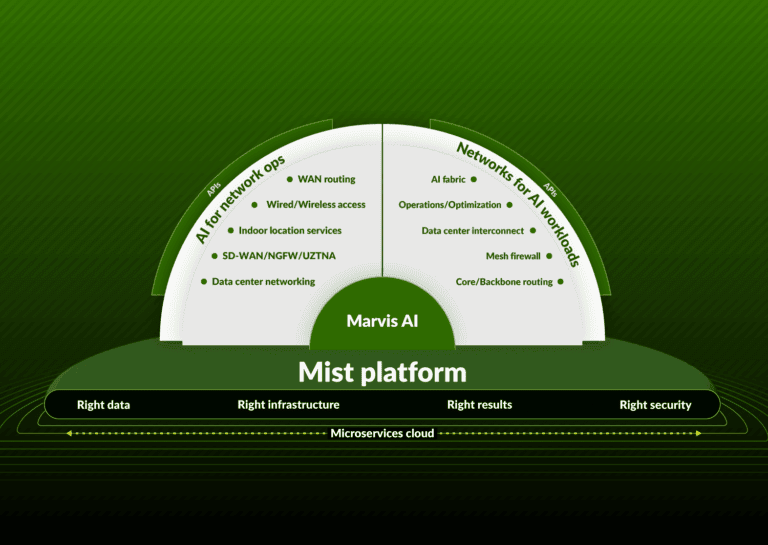Mist has been a pioneer in the field of AIOps for years. However, with the rise of agentic AI, this is taking on an extra dimension. Juniper has, of course, also recognized this. Agentic is an important link towards fully self-driving networks, something Juniper has been talking about for about 10 years.
Today, HPE Juniper Networking (as Juniper Networks has been called since its acquisition by HPE) announced several new features in its offering. AI naturally plays a central role in this. After all, Mist and the Marvis AI assistant have been pioneers in this field for years. Agentic will now also play a more important role in this. There is also an interesting expansion of Marvis Minis, and Juniper is tackling problems in video calls even better. Finally, a spokesperson for HPE Juniper Networking leaves no doubt about the future plans for the Juniper and Aruba portfolios: they will be merged.
Agentic AI Workflows
The main news today is that HPE Juniper Networking is adding agentic AI workflows to its AIOps offering. It added GenAI about a year ago, and with today’s addition, it is now possible to move towards real-time troubleshooting, said Jeff Aaron, VP of Product and Solutions Marketing, during a pre-briefing we attended.
It will be possible to query the agents available for LAN, WAN, and other domains using natural language from the standard interface of the Marvis AI Assistant. This should yield even better results. Aaron talks about the difference between Alex and Alexa Plus to illustrate the added value of the agentic additions compared to the old situation.
Aaron also makes it clear that the agentic additions to the AIOps interface do not require anything further from customers. In other words, they will be rolled out as an upgrade for existing licenses. “Customers will wake up one day, and Marvis will be smarter and using new tools,” says Aaron. During the same briefing, he also points out that Juniper has been doing things for a long time that are now seen as agentic, especially by other suppliers. These explicit agentic additions therefore also seem to be a response to Cisco’s announcements about AgenticOps a few months ago, particularly AI Canvas.
AIOps comes to the data center
AIOps as offered by Juniper with Mist has so far been primarily a campus story. That is now changing. The Marvis AI Assistant will be integrated with the graph database of Apstra, Juniper’s network software that focuses on data centers. Marvis Minis (read this story for more information) will also be available.
This expansion should also provide organizations with useful operational insights for the data center, making it more efficient and effective. In addition, this is a first step toward greater autonomy in that environment and caters to customers who use HPE Juniper for both campus and data center. It also gives HPE Juniper Networking further upsell opportunities, as it can now offer management for the entire organization.
Large Experience Model with Marvis Minis
The third of four announcements today is that the Large Experience Model (LEM) will now explicitly address issues in Zoom and Teams using Marvis Minis. Marvis Minis makes it possible to predict and prevent any problems with the use of those tools. Network traffic from tools such as Zoom and Teams is one of the most difficult to get right consistently.
“If you can solve issues with video calls, you’ve probably solved most of the problems in your network,” Aaron says. Zoom and Teams act as a canary in the coal mine, so to speak. If you’ve got that sorted, you can be sure that your network as a whole is in good shape.
More autonomy in Marvis Actions Dashboard
Finally, HPE Juniper Networking is adding more autonomy options to the Marvis AI Assistant dashboard. Users are given the option to set features to what is known as full autonomous mode. Examples include rebooting a failed network port or immediately updating an access point that is not compliant. Juniper does not set anything to this new mode by default. That remains something that users must decide for themselves and therefore enable. That is also how it should be. The decision always lies with the end user.
Finally: HPE Aruba Networking and HPE Juniper Networking are merging
Today’s announcements are still purely Juniper Networks announcements. In other words, these are things the company was already working on before the acquisition. What the future will look like is, of course, still anyone’s guess. There will undoubtedly be a roadmap from Juniper Networks (now HPE Juniper Networking) and from HPE Aruba Networking. The question is how much of this HPE will actually implement. HPE’s ambition is very clear. “Our vision is to bring all products and areas together under a single cloud and a single engine. One set of hardware, one back-end,” says Aaron.
The above ambition is, of course, a journey that HPE is embarking on. An integration of the agentic capabilities of Juniper/Mist into the recently announced GreenLake Intelligence by HPE is obvious. That does not seem to be an extremely complicated task. Merging the underlying layers (ASIC design, OS) is a lot more difficult. In any case, it is good that HPE is leaving no room for misunderstanding about its intentions. That creates clarity. It also makes sense for HPE to do this. “We now have a larger platform, a larger data lake, more engineers. Everything is coming together now,” concludes Aaron.
